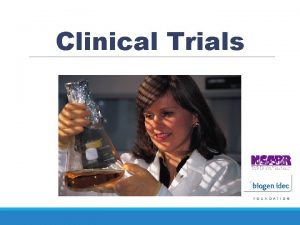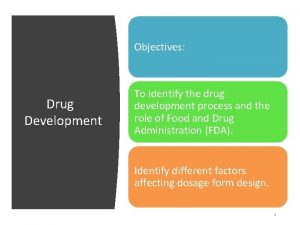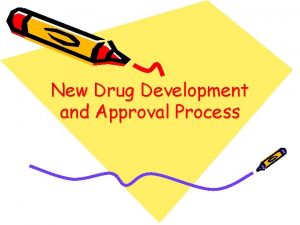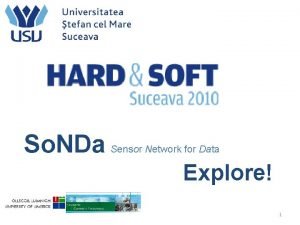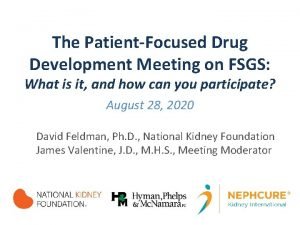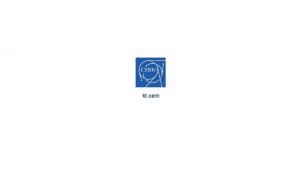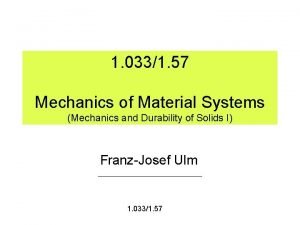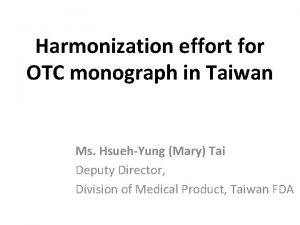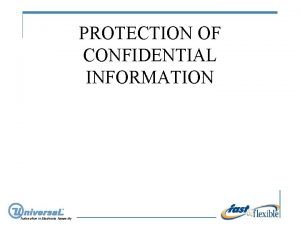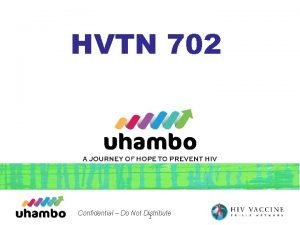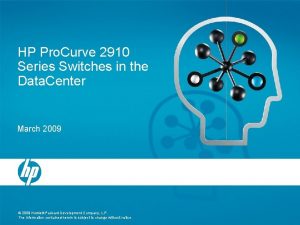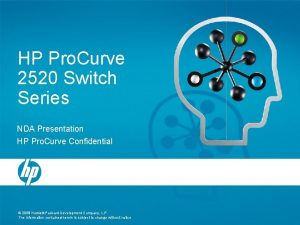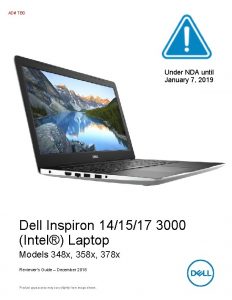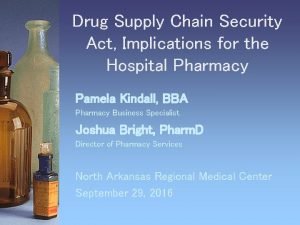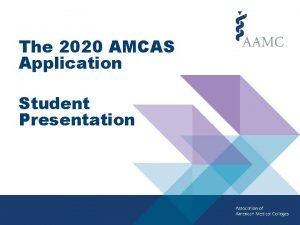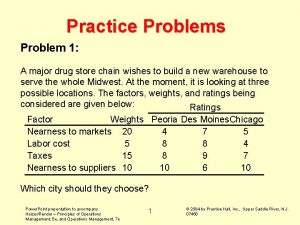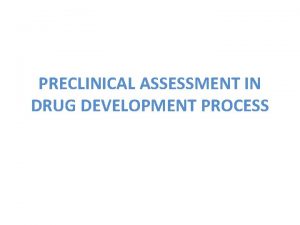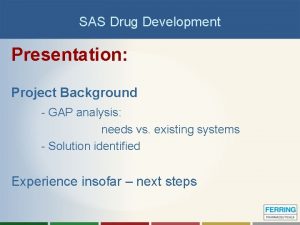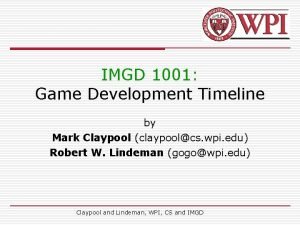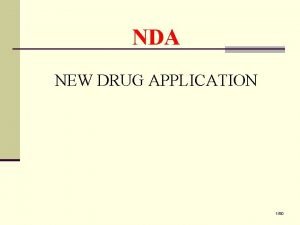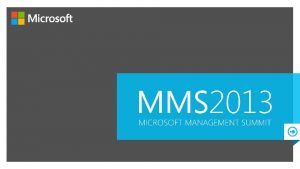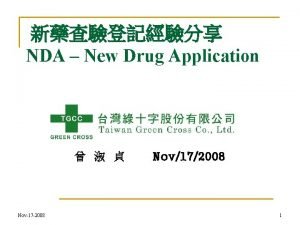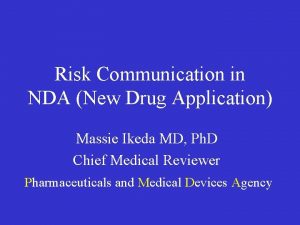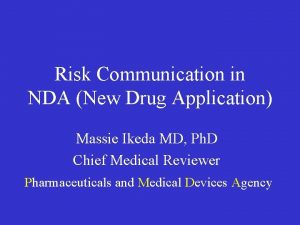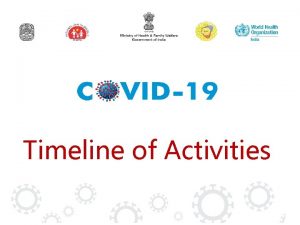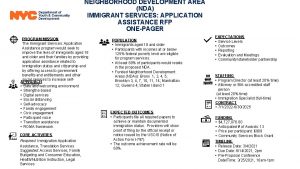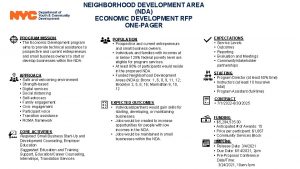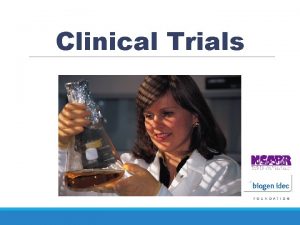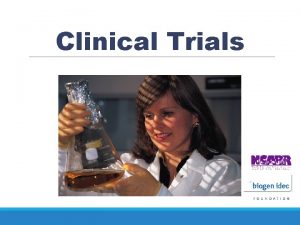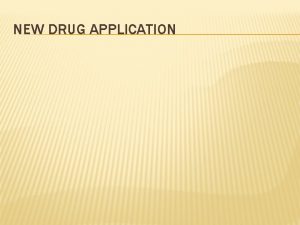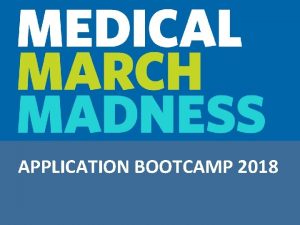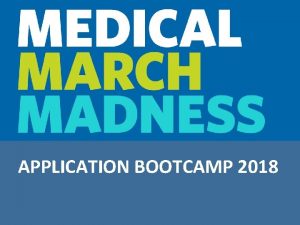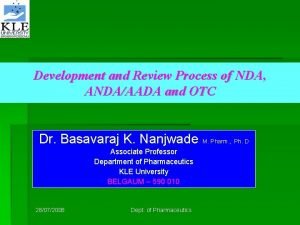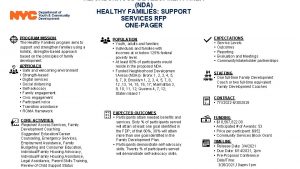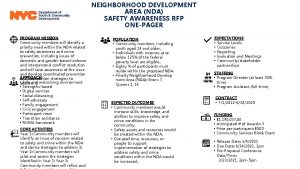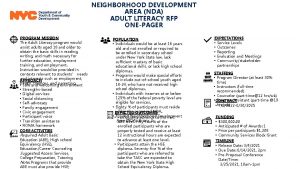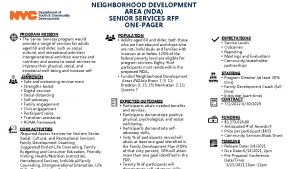NEW DRUG APPLICATION NDA DRUG DEVELOPMENT TIMELINE DiscoveryScreening






























- Slides: 30

NEW DRUG APPLICATION (NDA)

DRUG DEVELOPMENT TIMELINE Discovery/Screening PRE-CLINICAL RESEARCH ANIMAL TESTING SYNTHESIS AND PURIFICATION Avg. 18 mon. IND CLINICAL STUDIES Phase I Avg. 5 yrs Phase III NDA REVIEW NDA Avg. 12 month Approval POST MARKETING Adverse event survellance product defect reporting Survey sampling testing Post approval inspection

NEW DRUG APPLICATION The New Drug Application (NDA) is an application submitted to U. S. FDA for permission to market a new drug product in the united states. The goals of the NDA are to provide enough information to permit FDA reviewers to establish the following: 1. Whether the drug is safe and effective in its proposed use(s), and whether the benefits of the drug outweigh the risks? 2. Whether the drug’s proposed labeling appropriate, and what should it contain? 3. Are the methods used in manufacturing (Good Manufacturing Practices; GMP) of the drug and the controls used to maintain the drug’s quality adequate to preserve the drug’s identity, strength, quality, and purity?

To legally gather this data on safety and effectiveness in the U. S. , the maker must first obtain an Investigational New Drug (IND) designation from FDA. The documentation required in an NDA is supposed to tell the drug’s whole story, including, What happened during the clinical tests, What the ingredients of the drug formulation are, The results of the animal studies, How the drug behaves in the body, and How it is manufactured, processed and packaged. Once approval of an NDA is obtained, the new drug can be legally marketed starting that day in the U. S.

FUNDAMENTALS OF NDA SUBMISSIONS Although the quantity of information and data submitted in NDAs can vary significantly. The components of any NDA are a function of the nature of the subject drug and the information available to the applicant at the time of submission. The form to use for either NDA or ANDA is Form FDA-356 h, Application to Market a New Drug for Human Use or as an Antibiotic Drug for Human Use.

NDA CLASSIFICATIONS CDER classifies new drug applications with a code that reflects both the type of drug being submitted and its intended uses. New Molecular Entity New Salt of Previously Approved Drug New Formulation of Previously Approved Drug New Combination of Two or More Drugs New Indication for Already Marketed Drug , including switch in status to OTC (conversion of prescription drug to OTC) Already Marketed Drug Product without previously Approved NDA.

Fundamentals of NDA Submission As outlined in Form FDA-356 h, Application to Market a New Drug for Human Use Or As An Antibiotic Drug For Human Use, NDAs can consist of as many as 15 different sections: Index Summary Chemistry, Manufacturing, and Control; Samples, Method Validation Package, and Labeling Nonclinical Pharmacology and Toxicology Human Pharmacokinetics and Bioavailability Microbiology (for anti-microbial drugs only); Clinical Data; Safety Update Report Statistical; Case Report Tabulations; Case Report Forms; Patent Information; Patent Certification; and Other Information.

NDA REQUIRMENTS (I) Content and format of application (I) Formatting, assembling and submitting new drug and antibiotic applications (I) NDA summary format and content (II) NDA technical sections (III)Abbreviated new drug application

(I) Content and format of application: Although the exact requirements are a function of the nature of a specific drug, the NDA must provide all relevant data and information that a sponsor has collected during the product's research and development.

(II) Formatting, assembling and submitting new drug and antibiotic applications: A. Application format: The NDA regulations require the submission of Archival copy Review copy.

1. Archival copy: This is a complete copy of an application submission and is intended to serve as a reference source for FDA reviewers. This contains information which not contained in the review copy 2. Review copy: It is divided into five (or six) sections containing technical and scientific information required by FDA reviewers. Each of sections of review copy is separately bound. It should be provided with following: A copy of cover letter. A copy of application form (FDA 356 h) A copy of overall summary A copy of index to the entire application An index to the specific review section Both copies are submitted in hard copy.

The review copy is divided into six technical sections (“review sections”) and should be submitted with each review section separately bound in a specific color: (i) Chemistry, Manufacturing and Controls (CMC) – RED; (ii) Nonclinical Pharmacology and Toxicology – YELLOW; (iii) Human Pharmacokinetics and Bioavailability – ORANGE; (iv) Microbiology (if required) – WHITE; (v) Clinical Data – LIGHT BROWN; (vi) Statistical – GREEN.

B. Assembling the application: 1. Folders: Because of the procedure used at the FDA to file and retrieve material from the document rooms where applications are kept, it is necessary that applicants use the colored folders to bind the archival copy and each technical section. The cover of each folder should bear the NDA number (if known), name of applicant and name of drug product. 2. Paper size and binding: All applications must be bound on the left side of the page using the Unite States standard size loose leaf page. (8. 5″*11″). 3. Pagination: All pages in the application must be numbered and numbering of review copy pages should be same as the numbering of corresponding pages in archival copy.

4. Volume size and identification: Volume submitted in hard copy form should be no more than 2 inches thick. 5. Packing carton: The box size of 14″*12″*9. 5″ is recommended for shipment of applications to FDA. Because ANDAs are handled and stored separately, smaller boxes may be appropriate for them. 6. Supplements, Amendments and Post marketing Reports: The submission format for amendments to pending applications and supplements to approved applications will be same as an original application. Each submission will consist of two copies: a complete archival copy and an appropriately segmented review copy. Amendments, supplements, resubmissions annual reports and other correspondence concerning full applications should be addressed to appropriate FDA reviewing divisions.

(III) NDA SUMMARY FORMAT AND CONTENT: Summary should provide sufficient detail. Data should be provided in tabular or graphical form, . Summary should be between 50200 pages. A. Annotated package insert: This section include proposed text of the labeling for the product. The proposed text of the package labeling must be annotated by referance to volume and page number to the information in the summary and in technical sections of the applications. B. Pharmacological class, scientific rationale, intended use and potential clinical benefits: A brief statement should be includded to identify the pharmacological class of the drug, the scientific rationale for the drug, its intended use, and its potential clinical benefits.

C. Chemistry, Manufacturing and Controls: This summary must provide overview of the drug substances and the drug product. 1. Drug substance: It includes description about of drug substance, physical and chemical characteristics and stability of the drug substance. 2. Drug product: It includes information about: a. Composition and dosage form b. Name and address of manufacturer c. Container and closure system d. Stability e. Specifications for drug product and test methods to assure the specifications

D. Foreign Marketing History: If the product is marketed outside the U. S. , regardless of the dosage form, strength, salt, ester, or complex of the drug, the marketing history should be provided. This should include a list of countries in which drug product is marketed, with dates of marketing, if known. It must also include a list of any countries in which the drug has been withdrawn for any reason relating to safety or efficacy. Specific reason for withdrawal should be given. E. Nonclinical Pharmacology and Toxicology Summary: It includes information about: 1. Pharmacology studies 2. Acute toxicity studies 3. Multi dose toxicity studies 4. Carcinogenicity studies 5. Special toxicity studies 6. Reproduction studies 7. Mutagenicity studies 8. ADME studies

F. Human Pharmacokinetics and Bioavailability Summary: It includes brief description about bioavailability study of drug, pharmacokinetic characteristic of active ingredient and dissolution profile of drug. G. Microbiology Summary: It provides summary of results of the microbiologic studies conducted with anti-infective and antiviral drug. This includes mechanism of action, antimicrobial spectrum of action and mechanism of resistance to the drug. H. Clinical Data Summary and Results of Statistical Analysis: It is the basis of efficacy and safety that will determine an NDA approval. The Clinical Data Summary and Results of Statistical Analysis are divided into several parts as described below: Clinical pharmacology Overview of Clinical Studies Controlled Clinical Studies Uncontrolled Clinical Studies Other studies and Information Safety summary (general Safety Conclusions).

(IV) NDA technical sections: This includes brief description of the following sections. A. Chemistry, Manufacturing and Controls: It is the most critical portion of NDA or ANDA. This section must fully describe the composition of the drug substance (active ingredient), and its synthesis (or isolation) and purification, as well as applicable process controls, specifications, and analytical test methods.


C. Human Pharmacokinetics and Bioavailability Section: For a new chemical entity (NCE), it is desirable to determine its bioavailability and pharmacokinetics from the dosage form, except that for certain dosage forms (e. g. , iv solutions) 100% bioavailability may be assumed. For solid oral dosage forms (e. g. , capsule or tablet) a bioequivalence study is often necessary to demonstrate that formulation proposed for marketing is bioequivalent to whatever formulations may have been employed in early clinical trial. The summary should include a table with following pharmacokinetic parameter: Cmax, AUC, Tmax, kel, Vd, plasma and renal clearance and urine excretion. D. Microbiology: This section is of major importance for anti-infective drugs and includes data on the biochemical basis of the drug’s action and its antimicrobial spectra; any known mechanisms of resistance to the drug; and clinical laboratory methods.

E. Clinical Data Section: It is the most important and most complicated section of an NDA. It is the part that provides the safety and efficacy data on the drug for its intended use. F. Outline of Clinical Section: It includes 1. List of investigators; List of INDs and NDAs 2. Background / Overview of clinical investigations 3. Clinical pharmacology 4. Controlled clinical studies 5. Uncontrolled clinical studies 6. Other studies and information's 7. Integrated summary of efficacy 8. Integrated summary of safety 9. Drug abuse and over dosage information's 10. Integrated summary of benefits and risk of drugs

G. Samples, Methods Validation and Labeling: Samples should not be submitted to the FDA with the application. The reviewing chemist will contact the applicant and provide the laboratory address where samples should be sent. The applicant should prepare four representative samples in sufficient quantity to permit FDA to perform each test described in the application three times to determine whether the drug substance and drug product meet the specification given in the application. The archival copy of an application is required to contain copies of the label and all labeling proposed for the drug product. Methods-validation data must be-provided in triplicate because copies are forwarded to two FDA laboratories. H. Case Report Forms and Tabulations: The sponsor must submit data tabulations from each Phase II and Phase III study and also the case study report form for every clinical trial patient who died or withdrew from the study because of an adverse event.

I. Patent Information: Information must be submitted regarding any patent held by the sponsor that covers the drug substance, formulation, and composition of the drug product, or method of use. Upon approval of the NDA, this information is published in the FDA’s Orange Book (known formally as Approved Drug Products with Therapeutic Equivalence Evaluations) and serves as a guide to firms wishing to develop generic copies of the innovator’s product. J. Patent Certification. Upon receipt of an NDA, the FDA conducts a review of the application to determine its completeness. Within 60 days, the FDA either accepts the filing or sends the applicant a “refusal-to- file” letter. If the applicant receives a “refusal-to-file” letter, they can

Grounds for refusal to file the application include: Form FDA 356 h has not been completed. The format of the application is not correct. One or more item is missing from the content as described in the regulations. The manufacturing facilities are not ready for inspection. Complete and accurate translations of all parts of the application not in English are not included. There are no statements regarding GLP compliance for each of the non clinical studies. There are no statements regarding compliance with IRB and informed consent regulations for each of the clinical studies. The drug product is already covered by an approved NDA or ANDA.

Drug Sponsor NDA Application Filable? No Refuse to file letter issues Yes Reviewed by CDER Medical Biopharmaceutical Pharmacology Statistical Chemistry Microbiology Advisory Committee Meeting with Sponsor Review complete and acceptable

Review complete and acceptable Sponsor revices No Additional info. Or Revision Requested or Submitted (Amendment) Yes safety Applicant would ask to submit reports 4 months after initial submission No Labeling review Acceptable? Yes Inspections of sites acceptable? NDA action No Pending satisfactory results

At this stage FDA will send one of three possible action letters to the applicant: One possibility is a “Not Approvable Letter, ” which will list the deficiencies in the NDA and explain why it cannot be approved. The second possibility is an “Approvable Letter, ” which indicates that ultimately the drug product should be approved, but lists minor deficiencies and labeling changes that are needed before an approval. Requests for commitment for post-approval studies may be included. The third possibility is an “Approval Letter, ” it states that the drug is approved. An applicant may receive both an Approvable Letter and Approval Letter. Division director of CDER, signs and approve a letter that the product can be legally marketed, starting on that date


 Phase 4 trial
Phase 4 trial Abbreviated new drug application
Abbreviated new drug application New drug development and approval process
New drug development and approval process Dell nda
Dell nda Nda
Nda Nda strategic plan
Nda strategic plan Nda
Nda Netscout nda
Netscout nda Kt cern
Kt cern Nda full dac
Nda full dac Dac dee fly
Dac dee fly Nda
Nda Difference between nda and anda slideshare
Difference between nda and anda slideshare Kevlar
Kevlar Hvtn 702
Hvtn 702 Nda 2910
Nda 2910 Nda 2910
Nda 2910 Dell nda
Dell nda An example of crude drug adulterated with exhausted drug
An example of crude drug adulterated with exhausted drug Dscsa serialization timeline
Dscsa serialization timeline Aamc application timeline
Aamc application timeline Castes in brave new world
Castes in brave new world Lowest class in brave new world
Lowest class in brave new world A major drug store chain wishes to build a new warehouse
A major drug store chain wishes to build a new warehouse New drug delivery system
New drug delivery system New mexico timeline
New mexico timeline Career opportunities in biotechnology and drug development
Career opportunities in biotechnology and drug development What is preclinical
What is preclinical Sas drug development
Sas drug development Game development stages
Game development stages Game development timeline
Game development timeline
